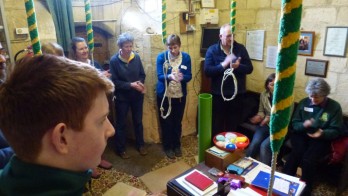M2: 14 Mar 2015 - Longcot
A warm welcome greeted my arrival at Longcot for the Module 2 course; the Tutor and Organisers were already prepared for the day ahead with kettle boiling. What better way to start the day – coffee and hot buttered crumpets?
After a short introduction we were into the first of three theory sessions. It was stressed to us that the learning was going to be fun and that is how we should make our sessions with our own learners. After a short time we made our way to the tower, the first task being to raise the bells. Then our group had its first practice session – teaching the other group how to ring fast and slow individually. After that it was our turn to ring rounds and then spin around to face the outside of the circle, the purpose of this being to listen to your bell.
It’s amazing how many learning methods there are that lead into Plain Bob Doubles. Even so, many of us who are used to ringing Plain Bob Doubles and more advanced methods had to check the blue line for some of these. I will certainly be using them from now on, as it will make the transition from call changes to plain hunt and Plain Bob so much easier for my learners.
The use of hand-clapping to simulate rounds is an excellent idea, especially when you close the eyes and then transfer that learning on to handbells. This helped all of us grasp the timing of the open hand stroke lead so much better. There is a myriad of diverse training aids that are available all to assist the learner and teacher alike and most are downloadable, from wipe clean plain hunt sheets to DVD’s.
All in all a very worthwhile day that was presented in a professional, but fun manner.
Kevin Musty

Course Tutor
Leslie Boyce
Teaching Elementary Change Ringing
Learn how to teach the skills of change ringing.